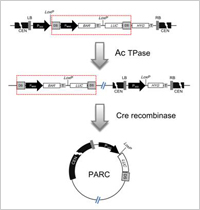Enlarge Image Figure 2. An outline of the method for generating plant artificial ring chromosomes.
Enlarge Image
Plant science: Plant models for crop breeding of the future
Minichromosomes have been extensively used as tools for revealing the functional structures of eukaryotic chromosomes. In the most popular model plant, Arabidopsis thaliana, however, only six different minichromosomes have been found or created to date, due to their extremely small sizes that limit detection by optical microscopy.
This review article summarizes the structure and stability of all the minichromosomes that Minoru Murata and colleagues at Okayama University have isolated since 2006, and describes their interesting features.
Minichromosomes vary from 1.7 Mb to 8.4 Mb in length and are much shorter than authentic chromosomes (25.3 Mb to 38.0 Mb). Linear and circular minichromosomes have been identified, and both types are maintained as experimental lines (Fig. 1). Intriguingly, most of the circular, ring-shaped minichromosomes in Arabidopsis are relatively stable at mitosis and transmissible to the next generation, regardless of the centromere form (dicentric or monocentric).
Recently, a ring minichromosome was artificially generated by a combination of the DNA sequence-specific recombination system, Cre/LoxP, and the DNA transposon system, Activator/Dissociation (Fig. 2, Murata et al. 2013). This artificial ring chromosome, AtARC1, has several advantages over the previously reported minichromosomes as a chromosome vector. Hence, Murata has proposed applying this method of generating plant artificial chromosomes to important crops for breed improvement in future.
Reference:
・Author: Minoru Murata
・Title of original paper: Minichromosomes and artificial chromosomes in Arabidopsis
・Journal, volume, pages and year: Chromosome Res, On-line first, May2, 2014.
・Digital Object Identifier (DOI): 10.1007/s10577-014-9421-0
・Affiliation: Institute of Plant Science and Resources, Okayama University


